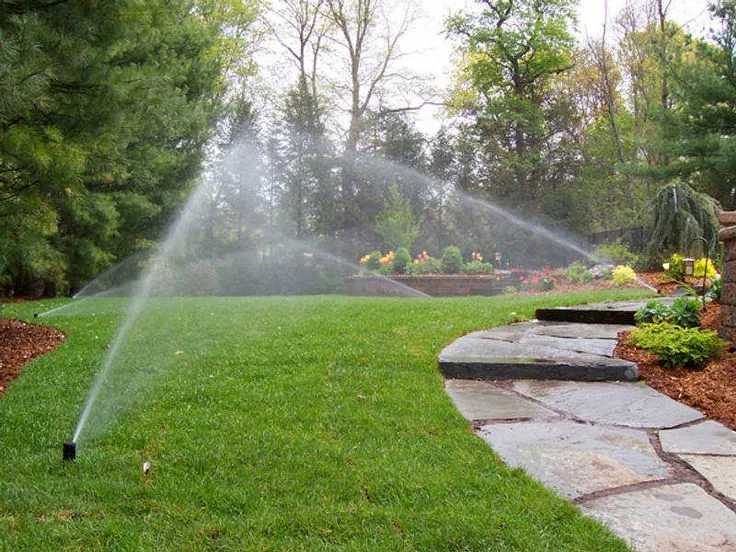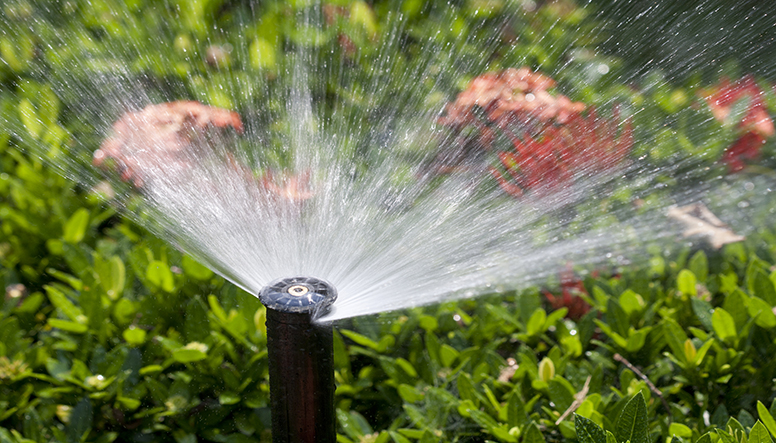Checking out the A Lot Of Typical Troubles in Lawn Sprinkler Solutions and Their Services
Sprinkler systems are essential for maintaining healthy and balanced landscapes, yet they frequently run into various issues. Typical concerns include blocked nozzles, busted pipes, and uneven watering patterns. Each of these can considerably impact system efficiency and water efficiency. Comprehending these problems and their solutions is vital for any kind of home owner. The complying with areas will outline normal difficulties and the essential repair services to keep a lawn sprinkler operating at its finest. What comes next off might surprise those not really prepared for maintenance facts.
Clogged Nozzles and Lawn Sprinkler Heads
Clogged nozzles and sprinkler heads are common problems that can substantially prevent the efficiency of a lawn sprinkler system. Over time, debris such as mineral, dust, and algae build-up can accumulate, blocking water circulation and leading to uneven coverage in the lawn or garden. This can result in certain locations obtaining not enough water, while others might come to be over-saturated.
Normal upkeep is vital to stop these obstructions. Regular checks can determine any kind of obstructions, and cleaning can frequently be accomplished with straightforward devices like a little brush or a toothpick. Sometimes, soaking clogged components in vinegar can help liquify natural resource.
For severe obstructions, replacement of the nozzle or head might be needed to recover correct feature. Attending to these issues quickly guarantees that the lawn sprinkler operates efficiently, maximizing and maintaining a healthy landscape water use.
Broken Water Lines and Leaks
Broken pipelines and leaks can greatly interrupt the functionality of a lawn sprinkler. Determining pipe damages early is necessary to prevent more problems, and recognizing repair work strategies can improve the procedure. Furthermore, implementing preventative upkeep tips can assist assure the durability of the system and lower the possibility of future problems.
Recognizing Pipe Damages
Just how can property owners properly identify pipeline damages in their sprinkler systems? To start, they should consistently examine their lawns for uncommon wet areas or merging water, which might indicate a leak. In addition, house owners can check their water costs for unusual boosts, recommending concealed leaks within the system. Observing the lawn sprinkler heads for uneven spray patterns or inadequate insurance coverage can also indicate possible pipeline issues. Listening for unusual noises, such as hissing or gurgling, may suggest air getting away from harmed pipes. Carrying out visual evaluations of subjected pipes for fractures or corrosion can help pinpoint problems. By employing these techniques, home owners can proactively detect and address pipeline damages in their lawn sprinkler systems before it results in extra substantial concerns.
Fixing Techniques Introduction
Attending to pipe damage in an automatic sprinkler calls for an organized method to fixings, specifically when handling breaks and leakages. The initial step commonly entails locating the damaged location, which can be accomplished through aesthetic examination or pressure testing. As soon as determined, the repair service method may differ; for little leakages, utilizing pipe sealer or epoxy can efficiently seal the afflicted section. In instances of considerable breaks, cutting out the harmed pipe sector and replacing it with brand-new piping, secured with ideal ports, is advisable. In addition, making sure proper placement and securing joints will assist protect against future problems. After fixings, detailed testing of the system is vital to verify that leakages have been solved and that the system runs properly.
Preventative Upkeep Tips
To reduce the risk of busted pipes and leakages in a lawn sprinkler, routine preventative upkeep is important. House owners ought to routinely evaluate the system for noticeable damage, making certain that fittings and pipelines are undamaged. Seasonal adjustments are essential; prior to winter, systems ought to be drained pipes to stop freezing, while spring checks can recognize wear from frost or shifting soil. Furthermore, maintaining the location around lawn sprinkler heads clear of debris helps prevent blockages that might cause leakages. Routinely testing water pressure can expose underlying problems, as extreme stress might strain pipes. Recording upkeep tasks can assist track efficiency and determine persisting issues, making it less complicated to attend to any kind of concerns proactively.
Unequal Watering Patterns
Unequal watering patterns can cause uneven grass and worried plants, coming from numerous reasons such as blocked nozzles or misaligned sprinkler heads. Identifying these issues is important for effective repair and ensuring regular water circulation across the landscape. Solutions may entail basic maintenance tasks or changes to the lawn sprinkler system for perfect performance.
Sources Of Uneven Watering
When a lawn sprinkler stops working to distribute water equally throughout a lawn, numerous aspects may add to this issue. One common cause is improper sprinkler head positioning, which can result in overlapping or not enough protection. Additionally, stopped up nozzles can restrict water circulation, leading to completely dry patches. Variants in water pressure can additionally affect circulation, as some areas might receive much more water than others. Irregular terrain or dirt compaction can affect exactly how water passes through the ground, leading to uneven absorption. The age of the sprinkler parts may result in reduced efficiency, contributing to irregular watering patterns. Identifying these causes is necessary for keeping a reliable lawn sprinkler and ensuring a healthy yard.
Solutions for Repairing Issues
Dealing with unequal watering patterns calls for a systematic technique to recognize and rectify underlying issues. Evaluating sprinkler heads for obstructions or damage is important; cleaning or replacing them can enhance water circulation. Next off, changing the automatic sprinkler's stress setups might aid achieve a more uniform spray. Additionally, assessing the layout of the sprinklers can reveal areas that need rearranging to assure coverage consistency. Checking for leakages in pipelines or installations is crucial, as leaks can result in uneven watering. Setting the timer to suit various zones based on plant needs can boost total performance. By carrying out these options, one can efficiently restore well balanced watering patterns within the landscape.
Timer and Control Concerns
A well-functioning timer is essential for peak sprinkler system efficiency, numerous homeowners run into problems that interrupt their watering schedules. Usual issues consist of malfunctioning programs, where timers might not show the desired watering times, causing over- or under-watering. Additionally, power blackouts can reset timers, triggering them to change to skip setups and ignoring the customized timetables property owners rely on. Malfunctions can likewise stem from out-of-date modern technology; older timers may do not have the functions essential for maximum control, such as rainfall sensing units or smart modern technology integration. Electrical wiring concerns can avoid signals from getting to the shutoffs, rendering the system inoperable. Regular upkeep and timely updates can aid ease these problems. House owners should take into consideration seeking advice from specialists for troubleshooting to guarantee their timers operate successfully and efficiently, as appropriate control is crucial for conserving and maintaining a healthy landscape water resources
Lawn Sprinkler Stress Troubles
How can insufficient water pressure effect a sprinkler system's effectiveness? Insufficient water stress can result in uneven water distribution, leading to dry patches and overwatered areas. This disparity compromises the general health and wellness of the landscape, as plants may struggle with either drought tension or root rot. Low stress can additionally prevent the procedure of sprinkler heads, preventing them from reaching their intended array and insurance coverage.
 Conversely, too much pressure can create damage to the system, bring about leaks or busted components. Ruptured pipelines and malfunctioning sprinkler heads might occur, incurring pricey repair work. Recognizing the source of pressure problems is important; common wrongdoers include clogged up filters, malfunctioning valves, or even metropolitan supply troubles. Routine system checks can assist maintain appropriate stress, ensuring a effective and effective automatic sprinkler. Correct pressure monitoring is important for peak efficiency and longevity of the irrigation system.
Conversely, too much pressure can create damage to the system, bring about leaks or busted components. Ruptured pipelines and malfunctioning sprinkler heads might occur, incurring pricey repair work. Recognizing the source of pressure problems is important; common wrongdoers include clogged up filters, malfunctioning valves, or even metropolitan supply troubles. Routine system checks can assist maintain appropriate stress, ensuring a effective and effective automatic sprinkler. Correct pressure monitoring is important for peak efficiency and longevity of the irrigation system.Seasonal Maintenance Tips
As the periods adjustment, applying regular maintenance for an automatic sprinkler ends up being crucial to assure peak performance and long life. Property owners need to start by examining the system prior to the onset of each season. In the spring, inspect for any winter season damage, tidy the nozzles, and readjust the spray patterns to suit brand-new development. Throughout the summertime, confirm that all areas are operating effectively, keeping an eye on for any kind of completely dry areas or overwatering. In the loss, it is important to prepare the system for winter season by draining the lines, blowing out the pipelines, and shielding any type of subjected elements. A thorough examination in the winter months can assist determine potential concerns that could develop in the springtime. Routine maintenance not just extends the life of the sprinkler system but additionally promotes a healthy landscape, reducing water waste and making certain an effective irrigation process throughout the year.

Troubleshooting Common Sprinkler Issues
What steps should homeowners take when confronted with usual sprinkler concerns? They should observe the system for visible indicators of breakdown, such as broken heads or wet spots, suggesting leakages. Next off, examining the timer setups and validating the system is set correctly is essential, as incorrectly set timers can cause overwatering or underwatering. Home owners need to likewise examine the shutoffs for clogs and validate they close and open effectively.
If the system reveals low tide stress, it may be because of a stopped up filter or a malfunctioning pump, requiring complete cleansing. Furthermore, house owners ought to confirm that the irrigation areas are operating individually and not overlapping, which can throw away water. If problems persist, speaking with a professional may be essential to detect and solve more complex troubles, validating the lawn sprinkler operates efficiently and properly.
Regularly Asked Concerns
How Typically Should I Examine My Sprinkler System?
A lawn sprinkler must be examined at least two times a year, ideally in springtime and autumn. Regular checks aid determine leaks, clogs, and various other concerns, making certain maximum performance and water effectiveness throughout the seasons.
Can I Mount an Automatic Sprinkler Myself?
Yes, an individual can mount a lawn sprinkler themselves, provided they have the essential tools, expertise, and skills. It is a good idea to speak with neighborhood policies and standards to ensure correct setup and compliance.
What Is the Ordinary Lifespan of a Lawn Sprinkler?
The average life expectancy of a lawn sprinkler generally varies from 10 to two decades, depending upon the top quality of materials, upkeep practices, and environmental problems, which can significantly influence its long life and general efficiency. sprinkler system repair.
Are There Eco-Friendly Options for Sprinkler Solutions?
Eco-friendly choices for automatic sprinkler consist of drip irrigation, rain sensing units, and clever controllers. These technologies save water, minimize drainage, and advertise reliable watering, making them sustainable choices for environmentally mindful home owners looking for effective irrigation services.
Exactly How Do Climate Problems Affect Sprinkler Performance?
Weather considerably influence lawn sprinkler efficiency; as an example, too much warmth can bring about dissipation, while hefty rains might trigger oversaturation. Furthermore, wind can interrupt water circulation, resulting in ineffective watering and uneven protection across landscapes.
Stopped up nozzles and lawn sprinkler heads are typical concerns that can considerably impede the efficiency of a lawn sprinkler system. When a lawn sprinkler system falls short to disperse water evenly across a lawn, a number of factors may contribute to this concern. A well-functioning timer here is critical for peak sprinkler system efficiency, numerous property owners experience problems that interrupt their irrigation timetables. Just how can insufficient water pressure influence a sprinkler system's effectiveness? Normal system checks can assist keep appropriate stress, making sure a efficient and reliable lawn sprinkler system.